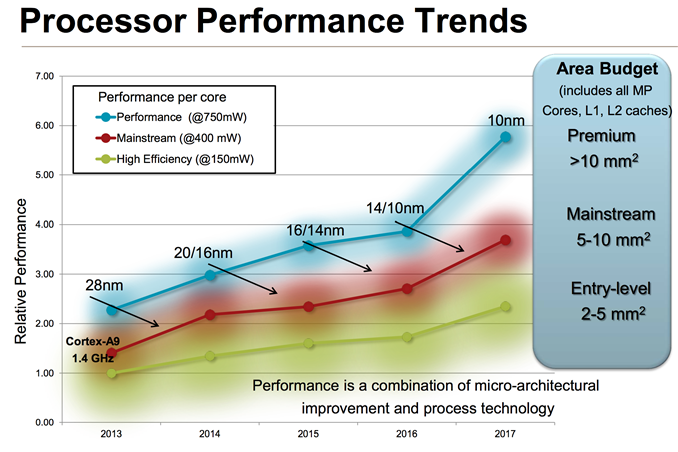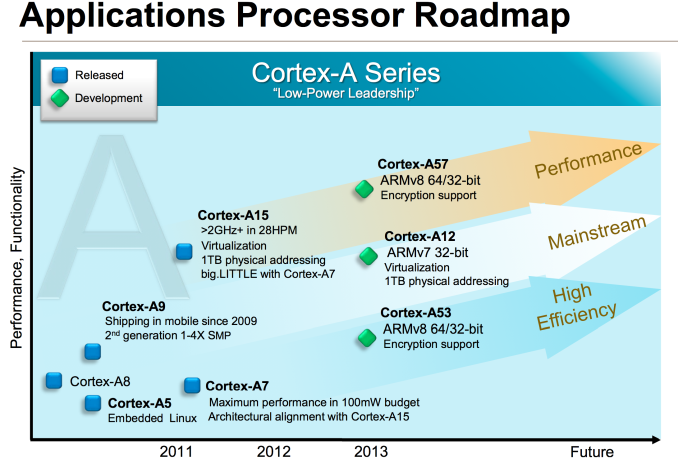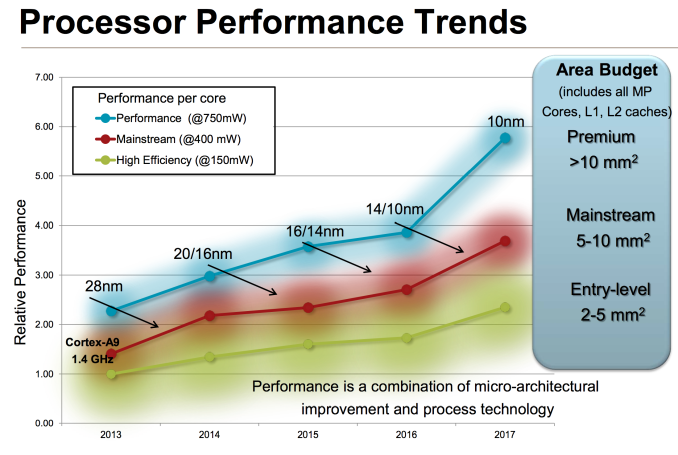The ARM Diaries, Part 2: Understanding the Cortex A12
by Anand Lal Shimpi on July 17, 2013 12:30 PM EST- Posted in
- CPUs
- Arm
- SoCs
- Cortex A12

A couple of weeks ago I began this series on ARM with a discussion of the company’s unique business model. In covering semiconductor companies we’ve come across many that are fabless, but it’s very rare that you come across a successful semiconductor company that doesn’t even sell a chip. ARM’s business entirely revolves around licensing IP for its instruction set as well as its own CPU (and now GPU and video) cores.
Before we get into discussions of specific cores, it’s important to talk about ARM’s portfolio as a whole. In the PC space we’re used to focusing on Intel’s latest and greatest microarchitectures, which are then scaled in various ways to hit lower price targets. We might see different core counts, cache sizes, frequencies and maybe even some unfortunate instruction set tweaking but for the most part Intel will deliver a single microarchitecture to cover the vast majority of the market. These days, this microarchitecture is simply known as Core.
Back in 2008, Intel introduced a second microarchitecture under the Atom brand to target lower cost (and lower power) markets. The combination of Atom and Core spans the overwhelming majority of the client computing market for Intel. The prices of these CPUs range from the low double digits with Atom to many hundreds of dollars for the highest end Core processors (the most expensive desktop Haswell is $350, however mobile now extends up to $1100). There are other designs that target servers (which are then repurposed for ultra high-end desktops), but those are beyond the scope of this discussion for now.
If we limit our discussion to personal computing devices (smartphones, tablets, laptops and desktops), where Intel uses two microarchitectures ARM uses three. The graphic below illustrates the roadmap:
You need to somewhat ignore the timescale on the x-axis since those dates really refer to when ARM IP is first available to licensees, not when products are shipping to consumers, but you get an idea for the three basic vectors of ARM’s Cortex A-series of processor IP. Note that there are also Cortex R (embedded) and Cortex M (microcontroller) series of processor IP offered as well, but once again those are beyond the scope of our discussion here.
If we look at currently available cores, there’s the Cortex A15 on the high end, Cortex A9 for the mainstream and Cortex A7 for entry/low cost markets. If we’re to draw parallels with Intel’s product lineup, the Cortex A15 is best aligned with ultra low power/low frequency Core parts (think Y-series SKUs), while the Cortex A9 vector parallels Atom. Cortex A7 on the other hand targets a core size/cost/power level that Intel doesn’t presently address. It’s this third category labeled high efficiency above that Intel doesn’t have a solution for. This answers the question of why ARM needs three microarchitectures while Intel only needs two: in mobile, ARM targets a broader spectrum of markets than Intel.
Dynamic Range
If you’ve read any of our smartphone/tablet SoC coverage over the past couple of years you’ll note that I’m always talking about an increasing dynamic range of power consumption in high-end smartphones and tablets. Each generation performance goes up, and with it typically comes a higher peak power consumption. Efficiency improvements (either through architecture, process technology or both) can make average power in a reasonable workload look better, but at full tilt we’ve been steadily marching towards higher peak power consumption regardless of SoC vendor. ARM provided a decent overview of the CPU power/area budget as well as expected performance over time of its CPU architectures:
Looking at the performance segment alone, we’ll quickly end up with microarchitectures that are no longer suited for mobile, either because they’re too big/costly or they draw too much power (or both).
The performance vector of ARM CPU IP exists because ARM has its sights set higher than conventional smartphones. Starting with the Cortex A57, ARM hopes to have a real chance in servers (and potentially even higher performance PCs, Windows RT and Chrome OS being obvious targets).
Although we see limited use of ARM’s Cortex A15 in smartphones today (some international versions of the Galaxy S 4), it’s very clear that for most phones a different point on the power/performance curve makes the most sense.
The Cortex A8 and A9 were really the ARM microarchitectures that drove smartphone performance over the past couple of years. The problem is that while ARM’s attentions shifted higher up the computing chain with Cortex A15, there was no successor to take the A9’s place. ARM’s counterpoint would be that Cortex A15 can be made suitable for lower power operation, however its partners (at least to date) seemed to be focused on extracting peak performance from the A15 rather than pursuing a conservative implementation designed for lower power operation. In many ways this makes sense. If you’re an SoC vendor that’s paying a premium for a large die CPU, you’re going to want to get the most performance possible out of the design. Only Apple seems to have embraced the idea of using die area to deliver lower power consumption.
The result of all of this is that the Cortex A9 needed a successor. For a while we’d been hearing about a new ARM architecture that would be faster than Cortex A9, but lower power (and lower performance) than Cortex A15. Presently, the only architecture in between comes from Qualcomm in the form of some Krait derivative. For ARM to not let its IP licensees down, it too needed a solution for the future of the mainstream smartphone market. Last month we were introduced to that very product: ARM’s Cortex A12.
Slotting in numerically between A9 and A15, the initial disclosure unfortunately didn’t come with a whole lot of actual information. Thankfully, we now have some color to add.












65 Comments
View All Comments
wumpus - Thursday, July 18, 2013 - link
Most of the analysis of MIPS implies that it has a chance at the embedded world, but not a prayer where the chips listed in this article play. I would assume that Imagination has a long term plan to break into this market, but it will take some sort of extreme cost/power/performance advantage to convince anyone to give up an architecture. There is a reason that ARM64 is still a dominant architecture, and it has nothing to do with any inherent superiority of the instruction set (indeed, it is a disaster and an unholy kludge. While most of the time "the backward stuff" might be irrelevant to modern computing, it still takes up area, has to be validated, and still has warts that have to be dealt with every design). Changing architectures isn't taken lightly (see how wonderfully windows RT is doing).Qwertilot - Thursday, July 18, 2013 - link
Isn't the business model the major reason for the architecture getting so dominant? Given how cheaply/freely they license the architecture, you need a really strong motivation and/or massive scale to consider using anything else. Limits ARMs size of course.Mondozai - Friday, July 19, 2013 - link
"There is a reason that ARM64 is still a dominant architecture, and it has nothing to do with any inherent superiority of the instruction set"Sorry that's just lazy.
ARM is where it is because no comptetitor has managed an alternative that is sufficiently competitive to their architecture.
Legacy isn't an issue. If ARM was going irrelevant, the switch would occur, and very fast too.
fteoath64 - Friday, July 19, 2013 - link
Qualcomm is not worried right now because it is busy with serving higher priced solutions and it could hardly supply those customers!. Besides, Qualcomm has access to next-gen process in volumes that can crush MediaTek , Actions, HiSilicon etc by dropping prices in the next-gen offerings. That market will run out for MediaTek within 12 months, so Qualcomm is playing the game right for now. All ARM licensees can do whatever they want as long as they stay within their contractual obligations. These Chinese licensees better be careful les they get cut off from the license and had to seek alternative architectures (meaning none, what going Intel is suicide!). The idea of MediaTek and others taking the "lower-tier" of the market for 3-4 quarters is enough for all to feast on the market. They do not want Intel to come in to cream everything off and leaves nothing for the partners to live on. There is strategy and turf protection, these are no dumb companies having made it this far. They know most of the tricks and can outwit the or else they will die. You should know the difference between Chinese vendors and western vendors, the Chinese manufacturers are happy to sell a wholesaler a phone for $110 when it cost them $80 to make. ie profit $30. The wholesaler turns around and sell it for $180 making $40-50 each after all the distribution costs etc. Western companies will see this unit for $300 retail!. The difference is greed even when the manufacturer provided goodwill in the factory price. The reason factories put a limited profit on each unit is to move the volumes because they know full well what the market price is going to be. They do not want to inflate it further.lilmoe - Thursday, July 18, 2013 - link
I'm sure you have valid points too, but you're not getting my side of the story. MediaTech's solution is pretty solid, yes, but it's strictly Cortex A9. Consumer demand, even in developing countries, is growing, and the need for faster chips is growing as well. By 2015, what makes you think that Krait wont be competitive in price with higher performance? Qualcomm needs only to re-badge their already developed chips with higher clock speeds.Profit margins are way higher in developed countries, it's just a matter of time that even current flagship devices be slashed in price (with a slight change in design and chassis) and they're ready to take on the cheapest Chinese OEMs have to offer...
Anyway, this doesn't change the fact that ARM made a mistake in its priorities. Cortex A15 (big.LITTLE) should have been targeted for 20/22nm and smaller processes. Priority should have been for Cortex A12. And yes, flagships (hero phones) could have made use of that core if it was ready by this time, especially since it could have competed really well with Krait in both power efficiency and performance (most probably beating it if ARM's claims are to be believed in that regard.
Qwertilot - Thursday, July 18, 2013 - link
The world, and A15 in particular, isn't just mobile phones :) The Samsung Chromebook, early versions of the micro server hardware, shield aren't all massive volume but they've started the process of starting to get Arm chips accepted in a bunch of device classes where they just didn't previously exist.(Phone wise it did end up powering a lot of S4's.).
You can see that could easily be more attractive/important as a priority for ARM than picking fights with existing licensees over high end mobile phones.
If Qualcomm/ (Intel too of course) end up directly taking on the cheapest that the Chinese OEMs have to offer they've basically already lost as there's then so little profit left. They have to somehow make the case for more expensive but also more powerful/efficient chips. At some point that'll get hard.
lilmoe - Thursday, July 18, 2013 - link
True, it isn't only for mobile devices (smartphones and tablets), but those make the absolute majority of demand. ARM has too much competition to face in the server world, a world that already has tons of existing x86 code. By the time they're ready to seriously fight in the server world, 14nm would be the norm.Again, my argument isn't about which chip goes where, or who should compete where, it's about timing and priorities of architecture designs, which ARM clearly screwed up on. At least that's how I see it.
Mondozai - Friday, July 19, 2013 - link
lilmoe wrote:"By 2015, what makes you think that Krait wont be competitive in price with higher performance? Qualcomm needs only to re-badge their already developed chips with higher clock speeds."
And what makes you think that the competition will stand still until that time?
They could get better SoC's based on the A-12 by that time, to just name one (out of many) possibilities.
lilmoe - Friday, July 19, 2013 - link
They WILL stand still because Cortex A12 isn't ready to ship yet. It'll be a good 2 years before it's "cheaply" manufactured by the likes of MediaTec.By the way, Krait powered Nokia Lumias are going for around and less than the $200 mark right now. People are forgetting that Android isn't the only contender in the market. OS market share will most probably look very different in 2015.
There are many dynamics running the low power processor market.
Wilco1 - Wednesday, July 17, 2013 - link
It's only late if you consider it a directly competitor of Silvermont. However A9R4 as used by Tegra 4i seems perfectly timed.